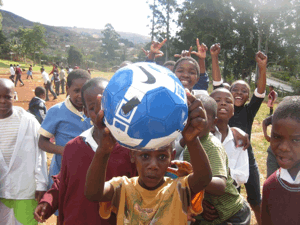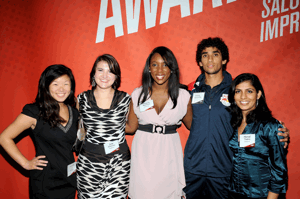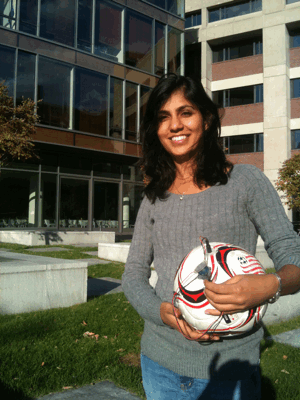Harnessing the Power of Soccer
Air Date: Week of October 29, 2010

An early sOccket prototype undergoes a battery of tests in KwaZulu Natal, South Africa. (Photo WhizzKids United)
Four Harvard students invented a soccer ball that charges with every kick. The young inventors hope to harness the power of soccer fanaticism and turn it into clean energy. Living on Earth and Planet Harmony’s Ike Sriskandarajah reports.
Transcript
GELLERMAN: A group of Harvard students is harnessing the power of the world’s most popular sport. They’ve built a soccer ball that charges with every kick, and post game can power a light. Popular Mechanics calls the ball one of the breakthrough innovations of the year. The creators call it the ‘sOccket.’ Living on Earth and Planet Harmony’s Ike Sriskandarjah has our story.
SRISKANDARAJAH: A group of four Harvard students is trying to tackle the problem of being off-the-grid with a solution on the field. Hemali Thakkar, a graduating senior, is one of the co-creators of sOccket.
THAKKAR: This is sOccket, it’s a soccer ball with the ability to generate electricity.
SRISKANDARAJAH: Thakkar holds up what, on the outside, looks like a regular white soccer ball, but inside…
THAKKAR: Every time you kick the ball there’s a magnet that goes back and forth through the inductive coil which allows a current to be captured in a capacitor and electricity can be stored and used later on.
SRISKANDARAJAH: Similar to a shake to charge flashlight…
THAKKAR: Shake to charge flashlight-- it’s the one where you shake it and the more you shake it, the more light you have.
[MUSIC: Outkast “Hey Ya” from The Love Below (LaFace 2003): “shake it, shake it, s-shake it, shake it like a Polaroid picture…”]
[KICKING A SOCCER BALL]

Popular Mechanics honored the sOccketeers as one of the Breakthrough Inventions of the year. From left to right: Jessica Lin, Jessica Matthews, Julia Silverman, New York Red Bulls player Medhi Ballouchy and Hemali Thakkar. (Photo: Popular Mechanics)
THAKKAR: So right now you need about 15 minutes of kicking the ball that allows us to use a single LED. It will be lit for three hours. So let me take you over to where the lamp is. So right now how you would use it, you would plug the lamp directly into the input that’s on the ball.
Voila! You can see the light.
SRISKANDARAJAH: A glowing reading light connects to a wire that ends in a DC plug, sticking out of the ball.
THAKKAR: You know when its pitch dark, its amazing how, like, a single LED can make such a big difference.
SRISKANDARAJAH: Making a difference was the goal of Thakkar and her three co-creators. The four of them, all women, non-engineers, had a class assignment to design a project that tackled a global social problem.
THAKKAR: And we saw that there was this universal love of soccer around the world and we saw this huge need for electricity and we said, ‘hey, why not, why not put the two together.’ And that’s how sOccket came about.
SRISKANDARAJAH: Soccer is often played in poor places and the UN Development Program estimates that nearly 80 percent of the Third World- the 50 poorest nations- has no access to electricity. And in those places people rely on unsustainable, unhealthy energy sources.
THAKKAR: And, what the problem is right now in developing countries is that a lot of people use kerosene. Kerosene lamps cause these fumes that are really bad every time you inhale them, so it causes respiratory illnesses. And those are supposed to be one of the biggest causes of morbidity and mortality in developing countries.
SRISKANDARAJAH: Over one and a half billion people worldwide use kerosene to light their homes. Respiratory infections account for the largest percentage of childhood deaths in developing nations. The environmental impact of kerosene is severe as well. The yearly carbon dioxide emissions from all those lamps around the world equals the emissions from about 38 million cars.

An early sOccket prototype undergoes a battery of tests in KwaZulu Natal, South Africa. (Photo WhizzKids United)
The Harvard team passed their ball off to a design firm to give shape to their idea. And this past summer, the sOccket team took their prototype to test it where the need for clean electricity and love of soccer was the highest.
[MUSIC: THEME SONG FROM THE SOUTH AFRICAN WORLD CUP: “Wavin’ Flay” by K’naan (A &M 2009)]
THAKKAR: We were able to take ten to 20 sOcckets to World Cup and it was in South Africa, which was the best place to be able to test sOcckets.
[MUSIC: THEME SONG FROM THE SOUTH AFRICAN WORLD CUP: “Wavin’ Flay” by K’naan (A &M 2009)]
SRISKANDARAJAH: The home of the 2010 world cup gave the sOccket inventors a great opportunity to see how their ball fared on some well-tread, no frills, South African fields.
The young women worked with Marcus McGilvray, founder of the South African based WhizzKids United. He runs a HIV care and prevention organization that uses soccer to reach at-risk kids. McGilvray had first met one of the Harvard inventors a year earlier and introduced her to his crack team of product testers.
MCGILVRAY: These children often, you know, they make footballs out of carrier bags and rolled up newspaper so they are always very excited when they have the opportunity to play with a football and then, of course, this football generated a lot of interest.

Hemali Thakkar holds up the latest, sOccket 2.0, at Harvard University. (Photo: Ike Sriskandarajah)
SRISKANDARAJAH: I asked him how the ball held up against his soccer-crazed kids.
MCGILVRAY: The ball stood up to the conditions and it held out really well.
SRISKANDARAJAH: But McGilvray also says there’s room for improvement.
MCGILVRAY: Certainly we could see that they were charging. What the sOccket team realized was though, from the trials, was that they were going to have to go back and actually work on the connection inside.
SRISKANDARAJAH: So the Harvard sOccketeers took these suggestions back and are hoping to have a new version of the ball on shelves next summer. Proceeds from American sales would support a buy one- give one model, so groups like Whizzkids in South Africa could start including the balls into their own programs teaching soccer and life skills.
MCGILVRAY: sOccket really gives it a whole new dimension to be able to show them what innovative inventions are coming up around the world. You know, it gets young people to think, ‘Wow!, You know, I think these are great things for children to learn from.’
American Express philanthropic, Members Project, created an ad for the sOccket.
SRISKANDARAJAH: A ball that powers an LED won’t end poverty or fix the environment. But it may inspire kids to think about other simple solutions to big problems and help people breathe a little easier. For Living on Earth and Planet Harmony, I’m Ike Sriskandarajah
Links
Learn more about HIV intervention through soccer at Whizz Kids' website
Living on Earth wants to hear from you!
Living on Earth
62 Calef Highway, Suite 212
Lee, NH 03861
Telephone: 617-287-4121
E-mail: comments@loe.org
Newsletter [Click here]
Donate to Living on Earth!
Living on Earth is an independent media program and relies entirely on contributions from listeners and institutions supporting public service. Please donate now to preserve an independent environmental voice.
NewsletterLiving on Earth offers a weekly delivery of the show's rundown to your mailbox. Sign up for our newsletter today!
 Sailors For The Sea: Be the change you want to sea.
Sailors For The Sea: Be the change you want to sea.
 The Grantham Foundation for the Protection of the Environment: Committed to protecting and improving the health of the global environment.
The Grantham Foundation for the Protection of the Environment: Committed to protecting and improving the health of the global environment.
 Contribute to Living on Earth and receive, as our gift to you, an archival print of one of Mark Seth Lender's extraordinary wildlife photographs. Follow the link to see Mark's current collection of photographs.
Contribute to Living on Earth and receive, as our gift to you, an archival print of one of Mark Seth Lender's extraordinary wildlife photographs. Follow the link to see Mark's current collection of photographs.
 Buy a signed copy of Mark Seth Lender's book Smeagull the Seagull & support Living on Earth
Buy a signed copy of Mark Seth Lender's book Smeagull the Seagull & support Living on Earth

